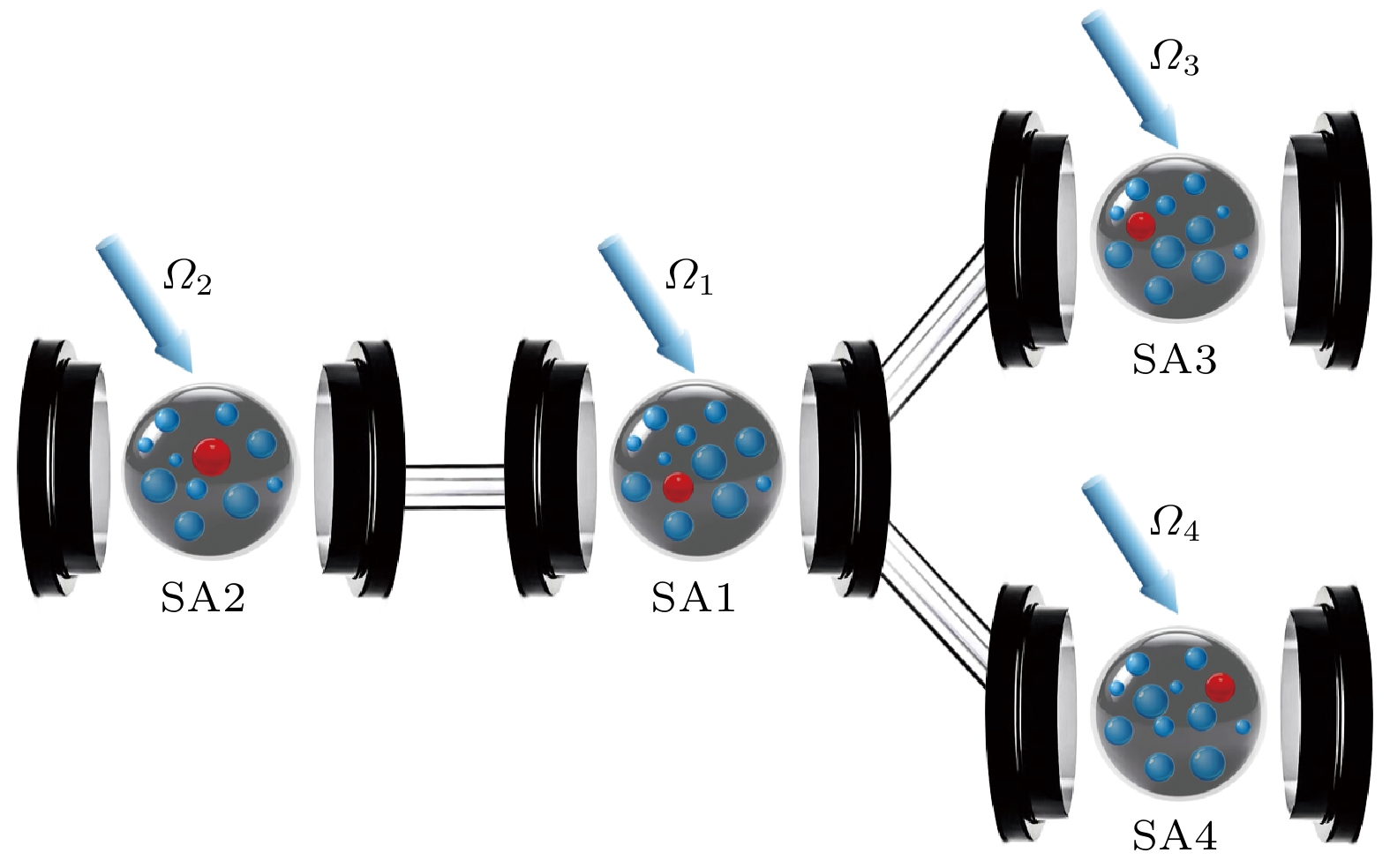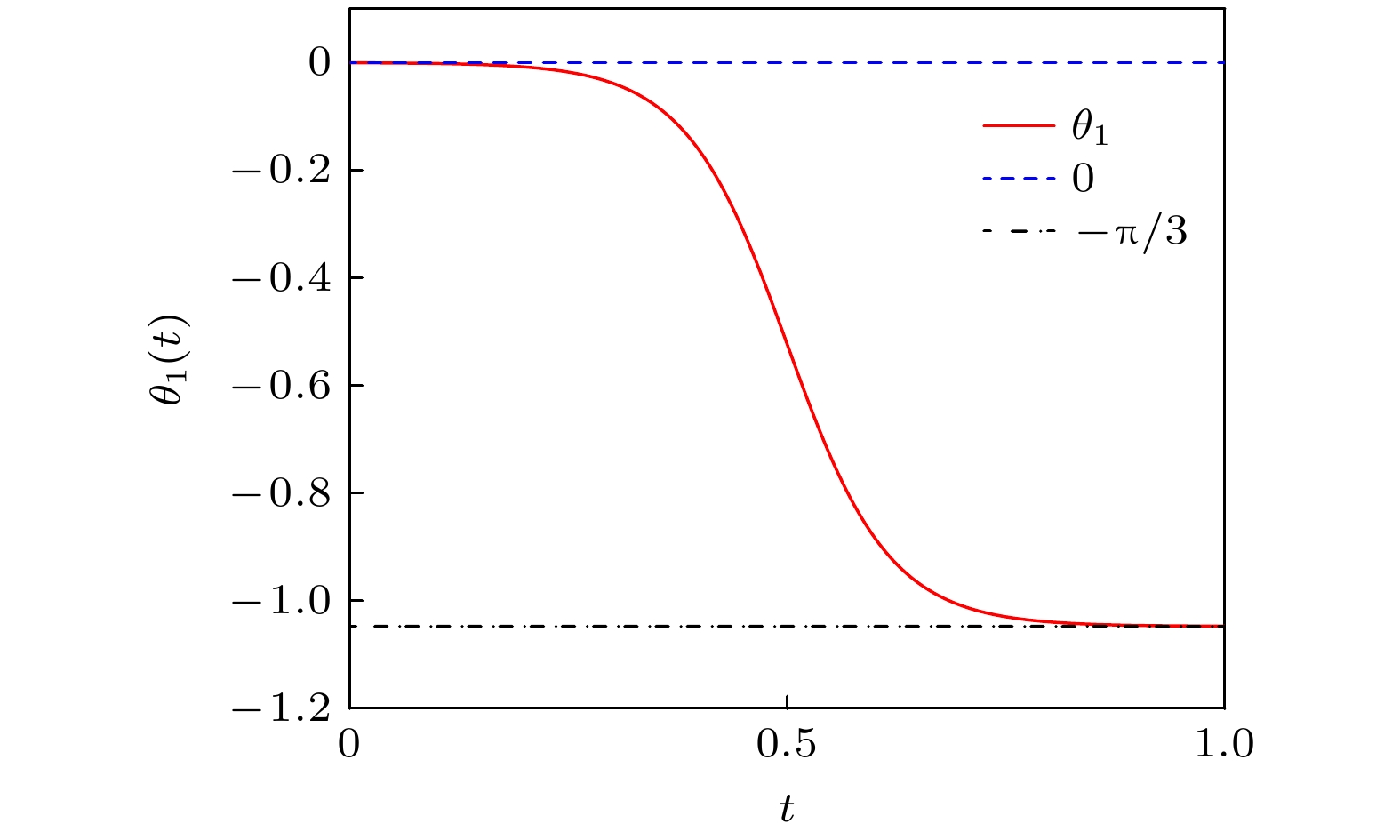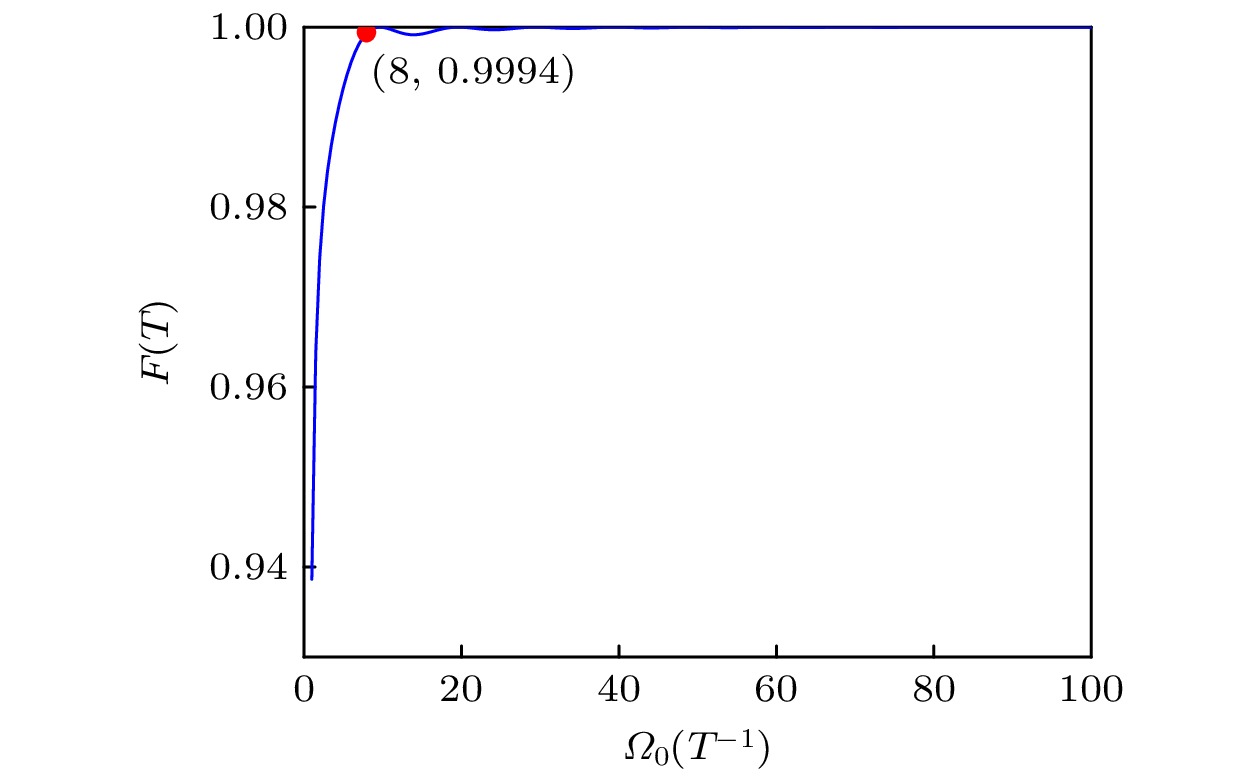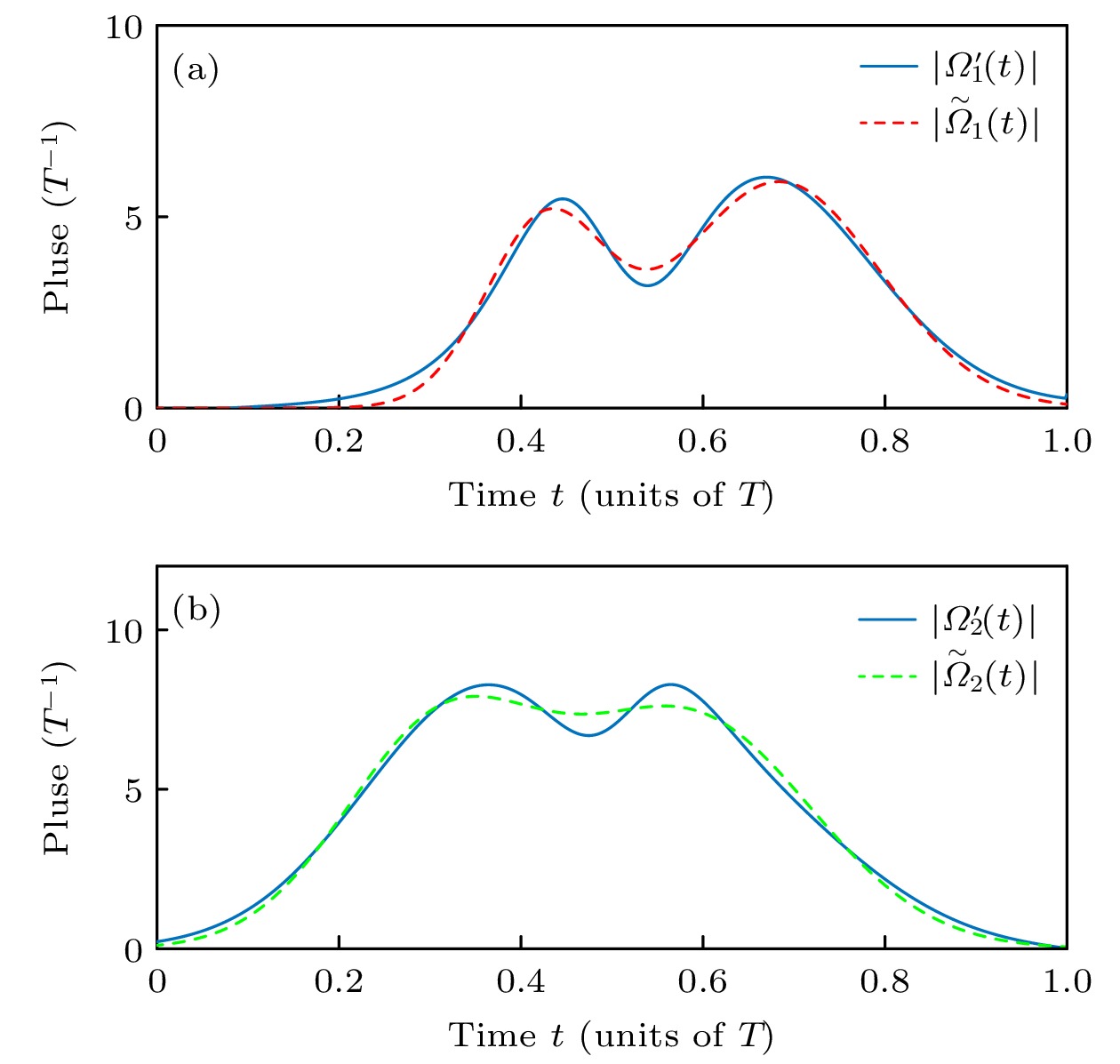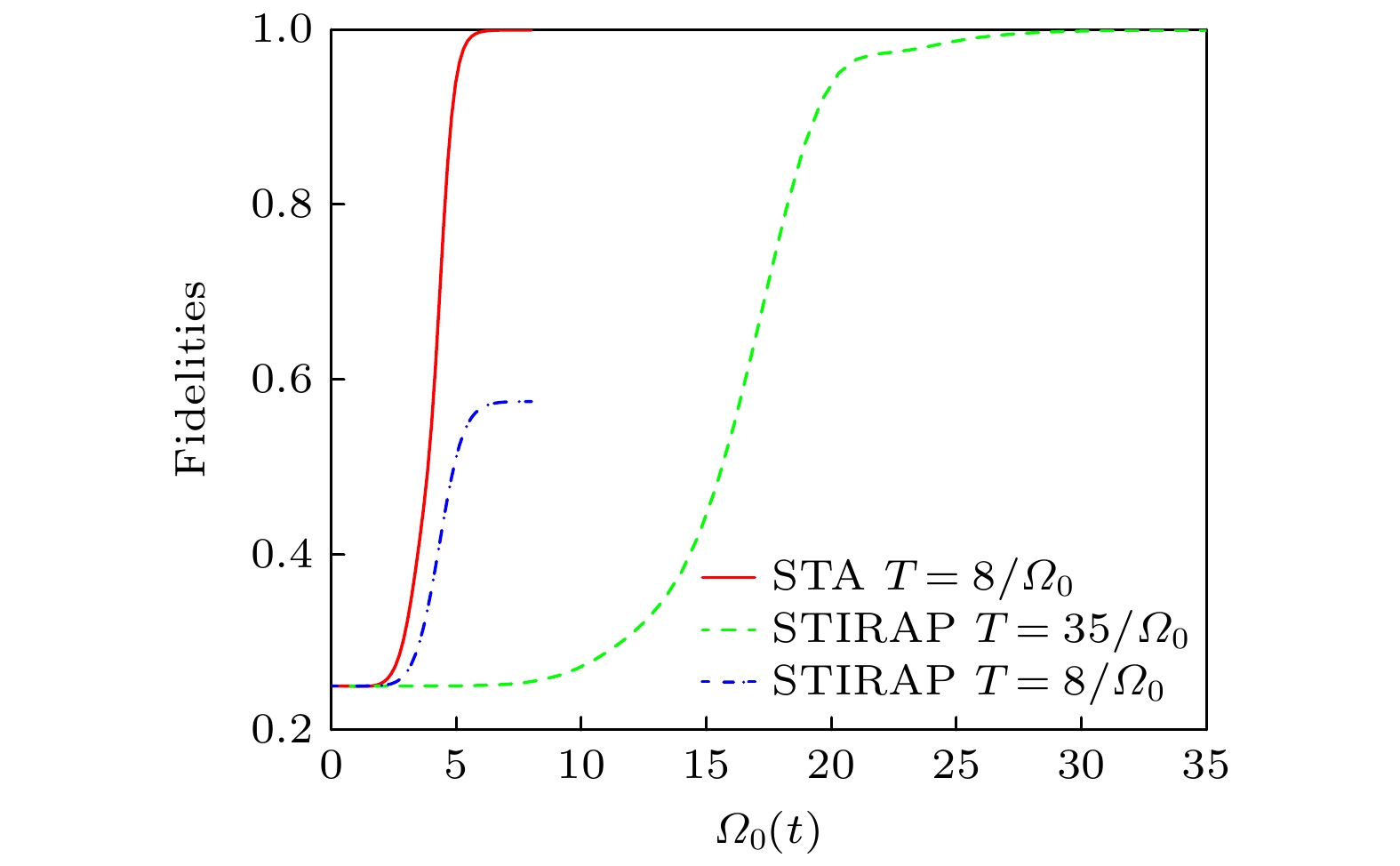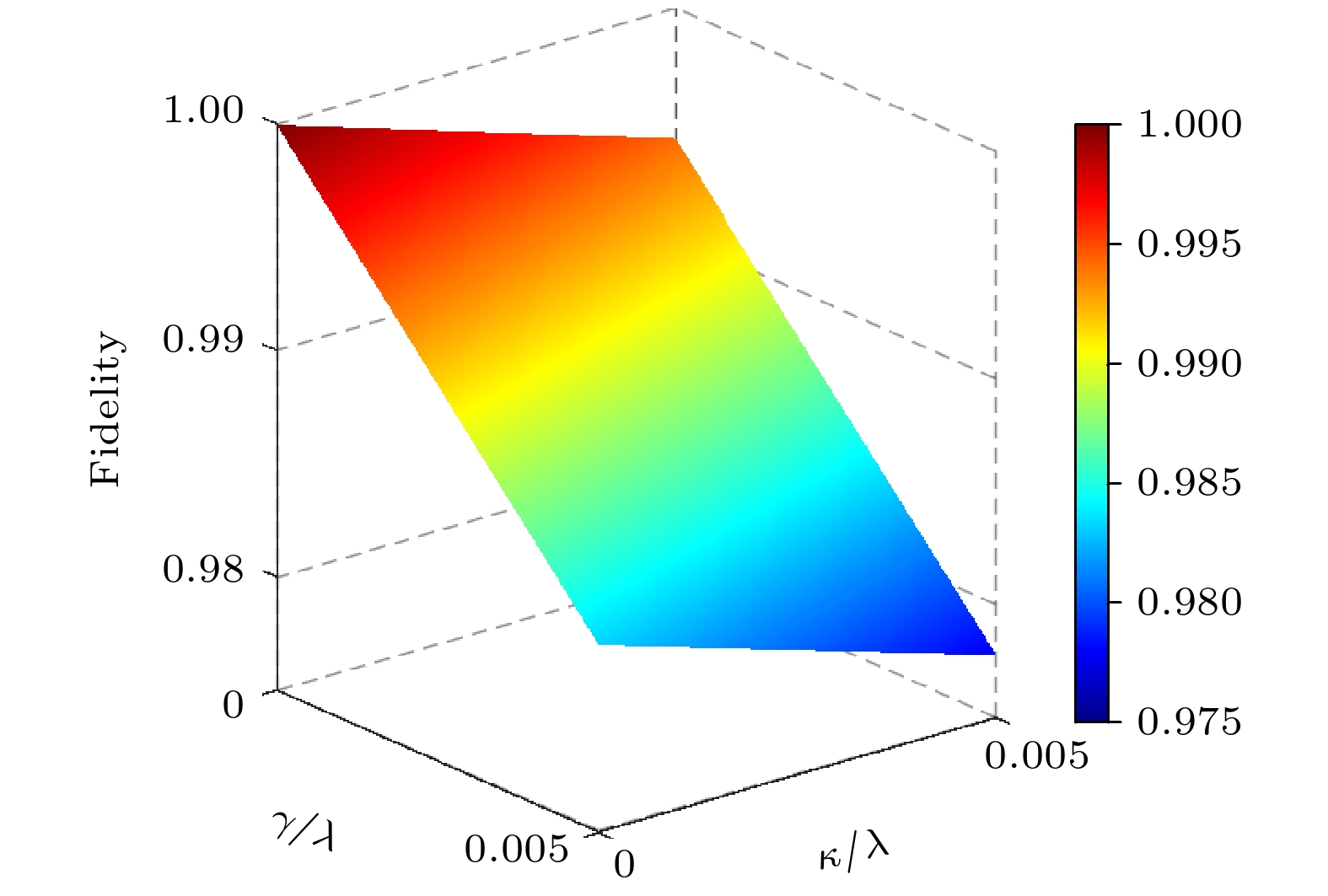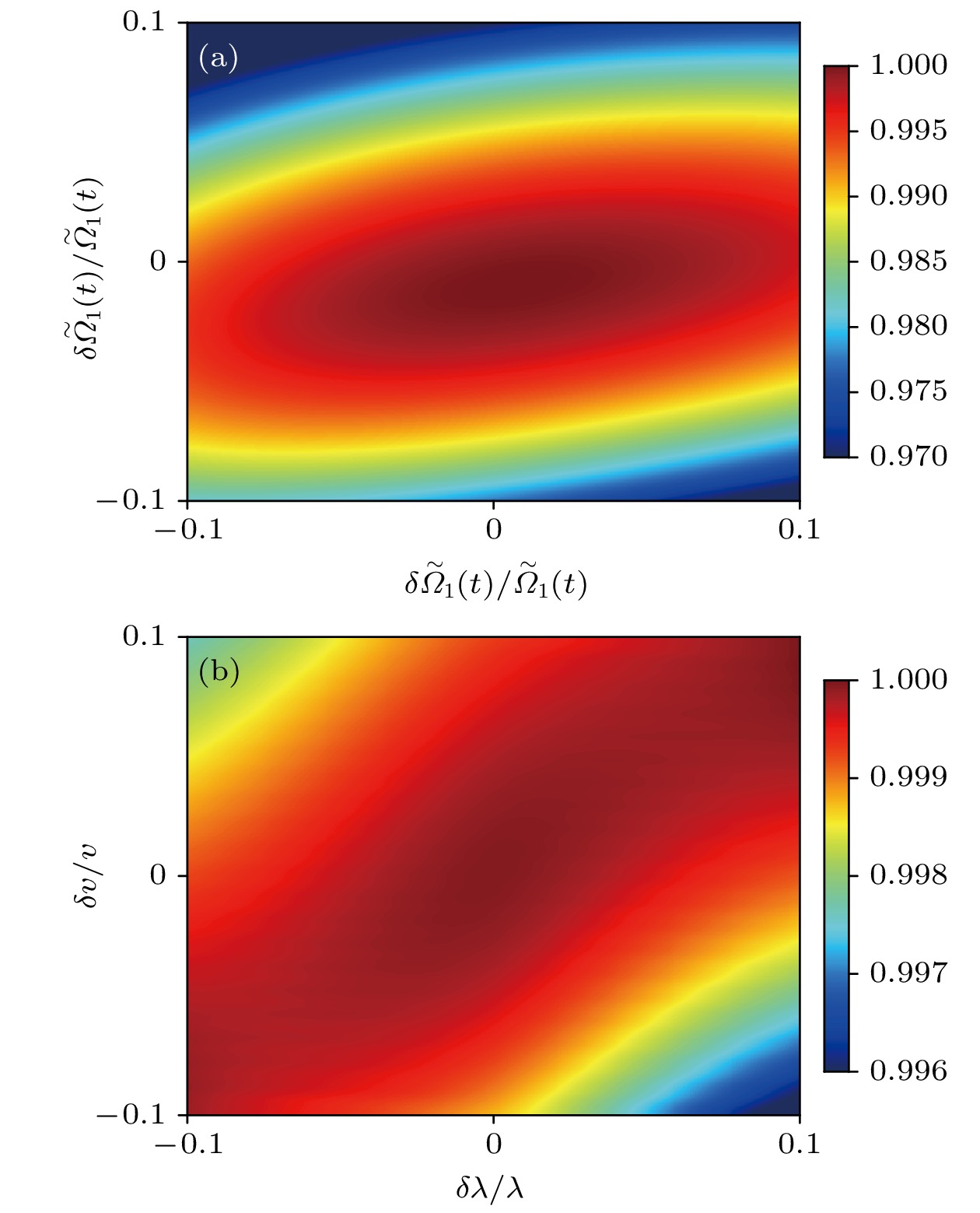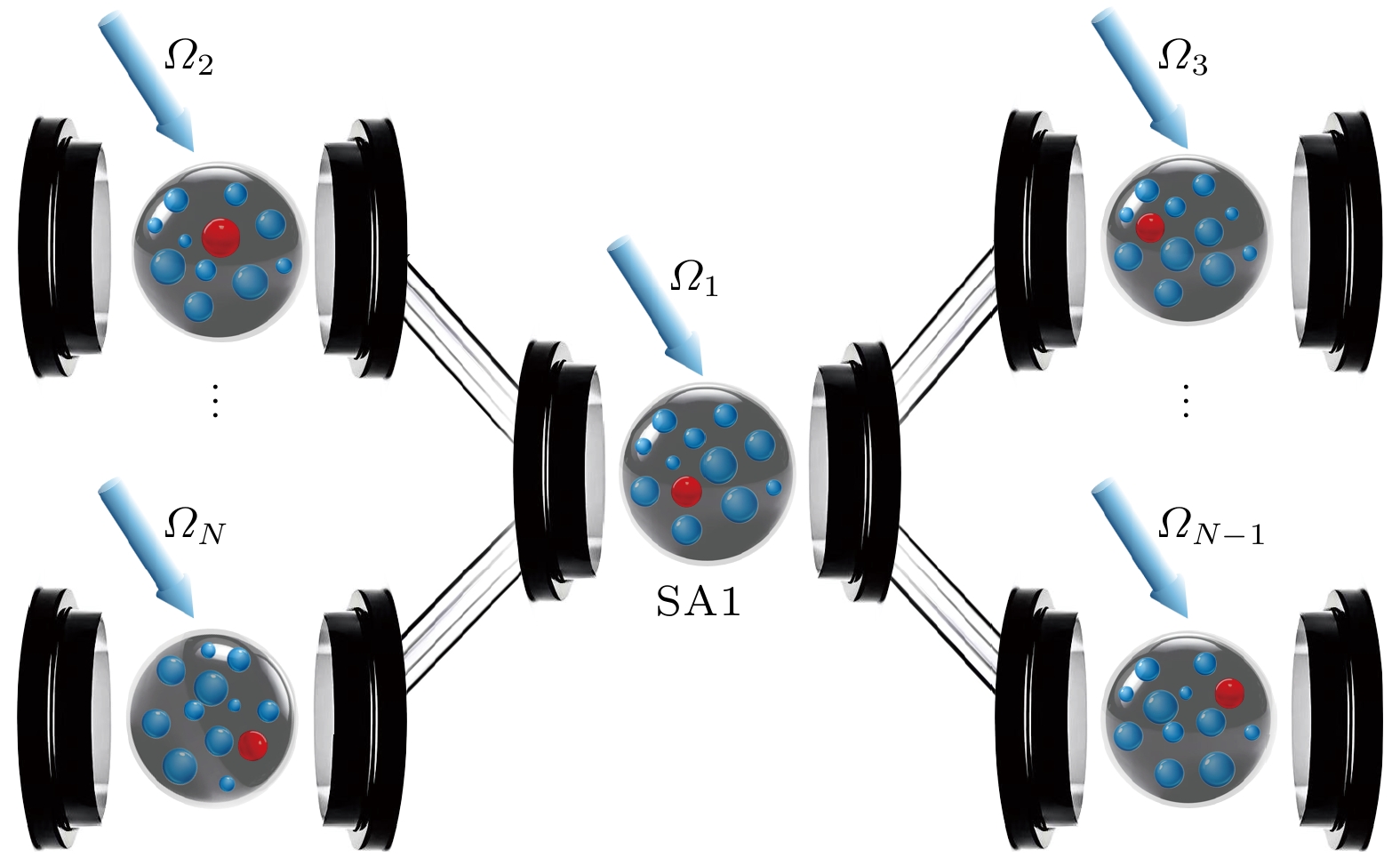-
The W state, as a robust multipartite entangled state, plays an important role in quantum information processing, quantum network construction and quantum computing. In this paper, a three-level ladder-type Rydberg atomic system is placed into a Rydberg blocking sphere to form a superatom. Each superatom has many collective states including just one Rydberg excitation constrained by the Rydberg blockade effect. In the weak cavity field limit, at most one atom can be pumped into excited state, then we can describe the superatom by using a three-level ladder-type system. Afterwards we encode quantum information about the effective energy levels of Rydberg superatoms and propose a fast scheme for preparing the Rydberg superatom W state based on the superadiabatic iterative technique and quantum Zeno dynamics.This scheme can be achieved in only one step by controlling the laser pulses. In this scheme, the superatoms are trapped in spatially separated cavities connected by optical fibers, thereby greatly improving the feasibility of experimental manipulation. A remarkable feature is that it does not need to accurately control experimental parameters and interaction time. Meanwhile, the form of counterdiabatic Hamiltonian is the same as that of the effective Hamiltonian. Through numerical simulations, the fidelity of this scheme can reach 99.94%. Even considering decoherence effects, including atomic spontaneous emission and photon leakage, the fidelity can still exceed 97.5%, thereby further demonstrating the strong robustness of the solution. In addition, the Rabi frequency can be characterized as a linear superposition of Gaussian functions, and this representation significantly alleviates the complexity encountered in practical experiments. Futhermore, we also analyze the influence of parameter fluctuations on the fidelity, and the results show that this scheme is robust against parameter fluctuations. Finally, the present scheme is extended to the case of N Rydberg superatoms, which shows the scalability of our scheme.
-
Keywords:
- superadiabatic /
- W state /
- Rydberg superatoms
[1] Gisin N, Ribordy G, Tittel W, Zbinden H 2002 Rev. Mod. Phys. 74 145
 Google Scholar
Google Scholar
[2] Markham D, Sanders B C 2008 Phys. Rev. A 78 042309
 Google Scholar
Google Scholar
[3] Bennett C H, Brassard G, Crépeau C, Jozsa R, Peres A, Wootters W K 1993 Phys. Rev. Lett. 70 1895
 Google Scholar
Google Scholar
[4] Luo Y H, Zhong H S, Erhard M, Wang X L, Peng L C, Krenn M, Jiang X, Li L, Liu N L, Lu C Y, Zeilinger A, Pan J W 2019 Phys. Rev. Lett. 123 070505
 Google Scholar
Google Scholar
[5] Xia Y, Song J, Lu P M, Song H S 2010 JOSA B 27 A1
 Google Scholar
Google Scholar
[6] Ekert A K 1991 Phys. Rev. Lett. 67 661
 Google Scholar
Google Scholar
[7] Bennett C H, Brassard G, Mermin N D 1992 Phys. Rev. Lett. 68 557
 Google Scholar
Google Scholar
[8] Long G L, Liu X S 2002 Phys. Rev. A 65 032302
 Google Scholar
Google Scholar
[9] Scarani V, Bechmann-Pasquinucci H, Cerf N J, Dušek M, Lütkenhaus N, Peev M 2009 Rev. Mod. Phys. 81 1301
 Google Scholar
Google Scholar
[10] Briegel H J, Browne D E, Dür W, Raussendorf R, Van den Nest M 2009 Nat. Phys. 5 19
 Google Scholar
Google Scholar
[11] Zhao P Z, Cui X D, Xu G, Sjöqvist E, Tong D 2017 Phys. Rev. A 96 052316
 Google Scholar
Google Scholar
[12] Su S L, Gao Y, Liang E, Zhang S 2017 Phys. Rev. A 95 022319
 Google Scholar
Google Scholar
[13] Wu J L, Su S L, Wang Y, Song J, Xia Y, Jiang Y Y 2020 Opt. Lett. 45 1200
 Google Scholar
Google Scholar
[14] Li X H, Deng F G, Zhou H Y 2006 Phys. Rev. A 74 054302
 Google Scholar
Google Scholar
[15] Zhu A D, Xia Y, Fan Q B, Zhang S 2006 Phys. Rev. A 73 022338
 Google Scholar
Google Scholar
[16] Li T, Long G L 2020 New J. Phys. 22 063017
 Google Scholar
Google Scholar
[17] Greenberger D M, Horne M A, Zeilinger A 1989 In Bell’s Theorem, Quantum Theory and Conceptions of the Universe (Springer) pp69–72
[18] Shao X Q, Liu F, Xue X W, Mu W, Li W B 2023 Phys. Rev. Appl 20 014014
 Google Scholar
Google Scholar
[19] Dür W, Vidal G, Cirac J I 2000 Phys. Rev. A 62 062314
 Google Scholar
Google Scholar
[20] Cabello A 2002 Phys. Rev. A 65 032108
 Google Scholar
Google Scholar
[21] Agrawal P, Pati A 2006 Phys. Rev. A 74 062320
 Google Scholar
Google Scholar
[22] Wang A, Wei Y Z, Li Z Y, Jiang M 2023 IET Quantum Commun. 4 200
 Google Scholar
Google Scholar
[23] Renner R 2008 Int. J. Quantum Inf. 6 1
 Google Scholar
Google Scholar
[24] Lo H K, Ma X, Chen K 2005 Phys. Rev. Lett. 94 230504
 Google Scholar
Google Scholar
[25] Lipinska V, Murta G, Wehner S 2018 Phys. Rev. A 98 052320
 Google Scholar
Google Scholar
[26] Miguel-Ramiro J, Riera-Sàbat F, Dür W 2023 PRX Quantum 4 040323
 Google Scholar
Google Scholar
[27] Su S L, Shao X Q, Wang H F, Zhang S 2014 Phys. Rev. A 90 054302
 Google Scholar
Google Scholar
[28] Han J X, Wu J L, Wang Y, Xia Y, Jiang Y Y, Song J 2021 Phys. Rev. A 103 032402
 Google Scholar
Google Scholar
[29] Shao X Q, Wang Z, Liu H, Yi X 2016 Phys. Rev. A 94 032307
 Google Scholar
Google Scholar
[30] Shao X Q, Su S L, Li L, Nath R, Wu J H, Li W 2024 Appl. Phys. Rev. 11 031320
 Google Scholar
Google Scholar
[31] Shao Q P, Wang J, Ji Y, Liu Y, Dong L, Xiu X M 2023 J. Opt. Soc. Am. B 41 143
 Google Scholar
Google Scholar
[32] Zhang W Y, Wang C Q, Ji Y Q, Shao Q P, Wang J P, Wang J, Yang L P, Dong L, Xiu X M 2024 Adv. Quantum Technol. 7 2300140
 Google Scholar
Google Scholar
[33] Saffman M, Walker T G, Mølmer K 2010 Rev. Mod. Phys. 82 2313
 Google Scholar
Google Scholar
[34] Beguin L, Vernier A, Chicireanu R, Lahaye T, Browaeys A 2013 Phys. Rev. Lett. 110 263201
 Google Scholar
Google Scholar
[35] Xing T, Zhao P, Tong D 2021 Phys. Rev. A 104 012618
 Google Scholar
Google Scholar
[36] Lukin M D, Fleischhauer M, Cote R, Duan L, Jaksch D, Cirac J I, Zoller P 2001 Phys. Rev. Lett. 87 037901
 Google Scholar
Google Scholar
[37] Urban E, Johnson T A, Henage T, Isenhower L, Yavuz D, Walker T, Saffman M 2009 Nat. Phys. 5 110
 Google Scholar
Google Scholar
[38] Gaëtan A, Miroshnychenko Y, Wilk T, Chotia A, Viteau M, Comparat D, Pillet P, Browaeys A, Grangier P 2009 Nat. Phys. 5 115
 Google Scholar
Google Scholar
[39] Wilk T, Gaëtan A, Evellin C, Wolters J, Miroshnychenko Y, Grangier P, Browaeys A 2010 Phys. Rev. Lett. 104 010502
 Google Scholar
Google Scholar
[40] Dudin Y O, Li L, Bariani F, Kuzmich A 2012 Nat. Phys. 8 790
 Google Scholar
Google Scholar
[41] Shao X Q, Wu J, Yi X 2017 Phys. Rev. A 95 062339
 Google Scholar
Google Scholar
[42] Su S L, Li W 2021 Phys. Rev. A 104 033716
 Google Scholar
Google Scholar
[43] Wu J L, Wang Y, Han J X, Su S L, Xia Y, Jiang Y, Song J 2021 Phys. Rev. A 103 012601
 Google Scholar
Google Scholar
[44] Zeiher J, Schauß P, Hild S, Macrì T, Bloch I, Gross C 2015 Phys. Rev. X 5 031015
 Google Scholar
Google Scholar
[45] Yang L, Wang J, Ji Y, Wang J, Zhang Z, Liu Y, Dong L, Xiu X 2024 Eur. Phys. J. Plus 139 1
 Google Scholar
Google Scholar
[46] Xu W, Venkatramani A V, Cantú S H, Šumarac T, Klüsener V, Lukin M D, Vuletić V 2021 Phys. Rev. Lett. 127 050501
 Google Scholar
Google Scholar
[47] Zhao P Z, Wu X, Xing T, Xu G, Tong D 2018 Phys. Rev. A 98 032313
 Google Scholar
Google Scholar
[48] Paris-Mandoki A, Braun C, Kumlin J, Tresp C, Mirgorodskiy I, Christaller F, Büchler H P, Hofferberth S 2017 Phys. Rev. X 7 041010
 Google Scholar
Google Scholar
[49] Liu Y L, Ji Y Q, Han X, Cui W X, Zhang S, Wang H F 2023 Adv. Quantum Technol. 6 2200173
 Google Scholar
Google Scholar
[50] Baksic A, Ribeiro H, Clerk A A 2016 Phys. Rev. Lett. 116 230503
 Google Scholar
Google Scholar
[51] Wu J L, Ji X, Zhang S 2017 Sci. Rep. 7 46255
 Google Scholar
Google Scholar
[52] Chen Y H, Qin W, Wang X, Miranowicz A, Nori F 2021 Phys. Rev. Lett. 126 023602
 Google Scholar
Google Scholar
[53] Giannelli L, Arimondo E 2014 Phys. Rev. A 89 033419
 Google Scholar
Google Scholar
[54] 王雪梅, 张安琪, 赵生妹 2022 71 150301
 Google Scholar
Google Scholar
Wang X M, Zhang A Q, Zhao S M 2022 Acta Phys. Sin. 71 150301
 Google Scholar
Google Scholar
[55] Berry M V 2009 J. Phys. A: Math. Theor. 42 365303
 Google Scholar
Google Scholar
[56] Ibáñez S, Chen X, Muga J 2013 Phys. Rev. A 87 043402
 Google Scholar
Google Scholar
[57] Song X K, Ai Q, Qiu J, Deng F G 2016 Phys. Rev. A 93 052324
 Google Scholar
Google Scholar
[58] Huang B H, Chen Y H, Wu Q C, Song J, Xia Y 2016 Laser Phys. Lett. 13 105202
 Google Scholar
Google Scholar
[59] Wu J L, Su S L, Ji X, Zhang S 2017 Ann. Phys. 386 34
 Google Scholar
Google Scholar
[60] Löw R, Weimer H, Nipper J, Balewski J B, Butscher B, Büchler H P, Pfau T 2012 J. Phys. B: At., Mol. Opt. Phys. 45 113001
 Google Scholar
Google Scholar
[61] Su S L, Sun L N, Liu B J, Yan L L, Yung M H, Li W, Feng M 2023 Phys. Rev. Appl. 19 044007
 Google Scholar
Google Scholar
[62] Du F F, Fan Z G, Ren X M, Ma M, Liu W Y 2024 Chin. Phys. B 34 010303
 Google Scholar
Google Scholar
[63] Shao X Q 2020 Phys. Rev. A 102 053118
 Google Scholar
Google Scholar
[64] Facchi P, Pascazio S 2002 Phys. Rev. Lett. 89 080401
 Google Scholar
Google Scholar
[65] Wu J L, Song C, Xu J, Yu L, Ji X, Zhang S 2016 Quantum Inf. Process. 15 3663
 Google Scholar
Google Scholar
[66] Shore B W 2017 Adv. Opt. Photonics 9 563
 Google Scholar
Google Scholar
[67] Zhang X, Isenhower L, Gill A, Walker T, Saffman M 2010 Phys. Rev. A 82 030306
 Google Scholar
Google Scholar
[68] Isenhower L, Urban E, Zhang X, Gill A, Henage T, Johnson T A, Walker T, Saffman M 2010 Phys. Rev. Lett. 104 010503
 Google Scholar
Google Scholar
[69] Guerlin C, Brion E, Esslinger T, Mølmer K 2010 Phys. Rev. A 82 053832
 Google Scholar
Google Scholar
[70] Zhang X F, Sun Q, Wen Y C, Liu W M, Eggert S, Ji A C 2013 Phys. Rev. Lett. 110 090402
 Google Scholar
Google Scholar
-
图 6 (a)对比脉冲$ \varOmega'_1(t) $和拟合的高斯脉冲$ \widetilde{\varOmega}_1(t) $; (b)对比脉冲$ \varOmega'_2(t) $和拟合的高斯脉冲$ \widetilde{\varOmega}_2(t) $
Figure 6. (a) Comparing the pulse $ \varOmega '_1 (t) $ and the fitting of gaussian pulse $ \widetilde {\varOmega} _1 (t) $; (b) comparing the pulse $ \varOmega '_2 (t) $ and the fitting of gaussian pulse $ \widetilde {\varOmega} _2 (t) $.
图 7 W态的保真度在超绝热迭代$ T = 8/\varOmega_0 $、绝热演化$ T = 8/\varOmega_0 $、绝热演化$ T = 35/\varOmega_0 $三种不同情况下随时间的变化
Figure 7. Under the three different conditions: superadiabatic iteration $ T = 8/\varOmega_0 $, adiabatic evolution $ T = 8/\varOmega_0 $ and adiabatic evolution $ T = 35/\varOmega_0 $, the fidelity of W state as a function of the time.
图 8 哈密顿量$ H_{{\mathrm{tot}}} $的控制下的W态的保真度与$ \kappa/\lambda $和$ \gamma/\lambda $的关系, $ T = 8/\varOmega_0, \varOmega_0 = 0.1\lambda $
Figure 8. The relationship between the fidelity of the W state and $ \kappa/\lambda $, $ \gamma/\lambda $ by the Hamiltonian $ H_{{\mathrm{tot}}} $, $ T = 8 / \varOmega_0, $$ \varOmega_0 = 0.1\lambda $.
图 10 N个里德伯超级原子-腔系统结构型的示意图, 每个里德伯超级原子被分别放置在不同的真空腔中, 第2到第N个腔均与第1个腔相连, $ \varOmega_N $是第N个腔中经典场驱动的拉比频率
Figure 10. Schematic diagram illustrating the structure of N-Rydberg superatom-cavity system, each of the Rydberg superatom is placed in a separate vacuum cavity, with cavities 2 through N all connected to cavity 1, $ \varOmega_N $ is the classical field-driven Rabi frequency in the N-th cavity.
-
[1] Gisin N, Ribordy G, Tittel W, Zbinden H 2002 Rev. Mod. Phys. 74 145
 Google Scholar
Google Scholar
[2] Markham D, Sanders B C 2008 Phys. Rev. A 78 042309
 Google Scholar
Google Scholar
[3] Bennett C H, Brassard G, Crépeau C, Jozsa R, Peres A, Wootters W K 1993 Phys. Rev. Lett. 70 1895
 Google Scholar
Google Scholar
[4] Luo Y H, Zhong H S, Erhard M, Wang X L, Peng L C, Krenn M, Jiang X, Li L, Liu N L, Lu C Y, Zeilinger A, Pan J W 2019 Phys. Rev. Lett. 123 070505
 Google Scholar
Google Scholar
[5] Xia Y, Song J, Lu P M, Song H S 2010 JOSA B 27 A1
 Google Scholar
Google Scholar
[6] Ekert A K 1991 Phys. Rev. Lett. 67 661
 Google Scholar
Google Scholar
[7] Bennett C H, Brassard G, Mermin N D 1992 Phys. Rev. Lett. 68 557
 Google Scholar
Google Scholar
[8] Long G L, Liu X S 2002 Phys. Rev. A 65 032302
 Google Scholar
Google Scholar
[9] Scarani V, Bechmann-Pasquinucci H, Cerf N J, Dušek M, Lütkenhaus N, Peev M 2009 Rev. Mod. Phys. 81 1301
 Google Scholar
Google Scholar
[10] Briegel H J, Browne D E, Dür W, Raussendorf R, Van den Nest M 2009 Nat. Phys. 5 19
 Google Scholar
Google Scholar
[11] Zhao P Z, Cui X D, Xu G, Sjöqvist E, Tong D 2017 Phys. Rev. A 96 052316
 Google Scholar
Google Scholar
[12] Su S L, Gao Y, Liang E, Zhang S 2017 Phys. Rev. A 95 022319
 Google Scholar
Google Scholar
[13] Wu J L, Su S L, Wang Y, Song J, Xia Y, Jiang Y Y 2020 Opt. Lett. 45 1200
 Google Scholar
Google Scholar
[14] Li X H, Deng F G, Zhou H Y 2006 Phys. Rev. A 74 054302
 Google Scholar
Google Scholar
[15] Zhu A D, Xia Y, Fan Q B, Zhang S 2006 Phys. Rev. A 73 022338
 Google Scholar
Google Scholar
[16] Li T, Long G L 2020 New J. Phys. 22 063017
 Google Scholar
Google Scholar
[17] Greenberger D M, Horne M A, Zeilinger A 1989 In Bell’s Theorem, Quantum Theory and Conceptions of the Universe (Springer) pp69–72
[18] Shao X Q, Liu F, Xue X W, Mu W, Li W B 2023 Phys. Rev. Appl 20 014014
 Google Scholar
Google Scholar
[19] Dür W, Vidal G, Cirac J I 2000 Phys. Rev. A 62 062314
 Google Scholar
Google Scholar
[20] Cabello A 2002 Phys. Rev. A 65 032108
 Google Scholar
Google Scholar
[21] Agrawal P, Pati A 2006 Phys. Rev. A 74 062320
 Google Scholar
Google Scholar
[22] Wang A, Wei Y Z, Li Z Y, Jiang M 2023 IET Quantum Commun. 4 200
 Google Scholar
Google Scholar
[23] Renner R 2008 Int. J. Quantum Inf. 6 1
 Google Scholar
Google Scholar
[24] Lo H K, Ma X, Chen K 2005 Phys. Rev. Lett. 94 230504
 Google Scholar
Google Scholar
[25] Lipinska V, Murta G, Wehner S 2018 Phys. Rev. A 98 052320
 Google Scholar
Google Scholar
[26] Miguel-Ramiro J, Riera-Sàbat F, Dür W 2023 PRX Quantum 4 040323
 Google Scholar
Google Scholar
[27] Su S L, Shao X Q, Wang H F, Zhang S 2014 Phys. Rev. A 90 054302
 Google Scholar
Google Scholar
[28] Han J X, Wu J L, Wang Y, Xia Y, Jiang Y Y, Song J 2021 Phys. Rev. A 103 032402
 Google Scholar
Google Scholar
[29] Shao X Q, Wang Z, Liu H, Yi X 2016 Phys. Rev. A 94 032307
 Google Scholar
Google Scholar
[30] Shao X Q, Su S L, Li L, Nath R, Wu J H, Li W 2024 Appl. Phys. Rev. 11 031320
 Google Scholar
Google Scholar
[31] Shao Q P, Wang J, Ji Y, Liu Y, Dong L, Xiu X M 2023 J. Opt. Soc. Am. B 41 143
 Google Scholar
Google Scholar
[32] Zhang W Y, Wang C Q, Ji Y Q, Shao Q P, Wang J P, Wang J, Yang L P, Dong L, Xiu X M 2024 Adv. Quantum Technol. 7 2300140
 Google Scholar
Google Scholar
[33] Saffman M, Walker T G, Mølmer K 2010 Rev. Mod. Phys. 82 2313
 Google Scholar
Google Scholar
[34] Beguin L, Vernier A, Chicireanu R, Lahaye T, Browaeys A 2013 Phys. Rev. Lett. 110 263201
 Google Scholar
Google Scholar
[35] Xing T, Zhao P, Tong D 2021 Phys. Rev. A 104 012618
 Google Scholar
Google Scholar
[36] Lukin M D, Fleischhauer M, Cote R, Duan L, Jaksch D, Cirac J I, Zoller P 2001 Phys. Rev. Lett. 87 037901
 Google Scholar
Google Scholar
[37] Urban E, Johnson T A, Henage T, Isenhower L, Yavuz D, Walker T, Saffman M 2009 Nat. Phys. 5 110
 Google Scholar
Google Scholar
[38] Gaëtan A, Miroshnychenko Y, Wilk T, Chotia A, Viteau M, Comparat D, Pillet P, Browaeys A, Grangier P 2009 Nat. Phys. 5 115
 Google Scholar
Google Scholar
[39] Wilk T, Gaëtan A, Evellin C, Wolters J, Miroshnychenko Y, Grangier P, Browaeys A 2010 Phys. Rev. Lett. 104 010502
 Google Scholar
Google Scholar
[40] Dudin Y O, Li L, Bariani F, Kuzmich A 2012 Nat. Phys. 8 790
 Google Scholar
Google Scholar
[41] Shao X Q, Wu J, Yi X 2017 Phys. Rev. A 95 062339
 Google Scholar
Google Scholar
[42] Su S L, Li W 2021 Phys. Rev. A 104 033716
 Google Scholar
Google Scholar
[43] Wu J L, Wang Y, Han J X, Su S L, Xia Y, Jiang Y, Song J 2021 Phys. Rev. A 103 012601
 Google Scholar
Google Scholar
[44] Zeiher J, Schauß P, Hild S, Macrì T, Bloch I, Gross C 2015 Phys. Rev. X 5 031015
 Google Scholar
Google Scholar
[45] Yang L, Wang J, Ji Y, Wang J, Zhang Z, Liu Y, Dong L, Xiu X 2024 Eur. Phys. J. Plus 139 1
 Google Scholar
Google Scholar
[46] Xu W, Venkatramani A V, Cantú S H, Šumarac T, Klüsener V, Lukin M D, Vuletić V 2021 Phys. Rev. Lett. 127 050501
 Google Scholar
Google Scholar
[47] Zhao P Z, Wu X, Xing T, Xu G, Tong D 2018 Phys. Rev. A 98 032313
 Google Scholar
Google Scholar
[48] Paris-Mandoki A, Braun C, Kumlin J, Tresp C, Mirgorodskiy I, Christaller F, Büchler H P, Hofferberth S 2017 Phys. Rev. X 7 041010
 Google Scholar
Google Scholar
[49] Liu Y L, Ji Y Q, Han X, Cui W X, Zhang S, Wang H F 2023 Adv. Quantum Technol. 6 2200173
 Google Scholar
Google Scholar
[50] Baksic A, Ribeiro H, Clerk A A 2016 Phys. Rev. Lett. 116 230503
 Google Scholar
Google Scholar
[51] Wu J L, Ji X, Zhang S 2017 Sci. Rep. 7 46255
 Google Scholar
Google Scholar
[52] Chen Y H, Qin W, Wang X, Miranowicz A, Nori F 2021 Phys. Rev. Lett. 126 023602
 Google Scholar
Google Scholar
[53] Giannelli L, Arimondo E 2014 Phys. Rev. A 89 033419
 Google Scholar
Google Scholar
[54] 王雪梅, 张安琪, 赵生妹 2022 71 150301
 Google Scholar
Google Scholar
Wang X M, Zhang A Q, Zhao S M 2022 Acta Phys. Sin. 71 150301
 Google Scholar
Google Scholar
[55] Berry M V 2009 J. Phys. A: Math. Theor. 42 365303
 Google Scholar
Google Scholar
[56] Ibáñez S, Chen X, Muga J 2013 Phys. Rev. A 87 043402
 Google Scholar
Google Scholar
[57] Song X K, Ai Q, Qiu J, Deng F G 2016 Phys. Rev. A 93 052324
 Google Scholar
Google Scholar
[58] Huang B H, Chen Y H, Wu Q C, Song J, Xia Y 2016 Laser Phys. Lett. 13 105202
 Google Scholar
Google Scholar
[59] Wu J L, Su S L, Ji X, Zhang S 2017 Ann. Phys. 386 34
 Google Scholar
Google Scholar
[60] Löw R, Weimer H, Nipper J, Balewski J B, Butscher B, Büchler H P, Pfau T 2012 J. Phys. B: At., Mol. Opt. Phys. 45 113001
 Google Scholar
Google Scholar
[61] Su S L, Sun L N, Liu B J, Yan L L, Yung M H, Li W, Feng M 2023 Phys. Rev. Appl. 19 044007
 Google Scholar
Google Scholar
[62] Du F F, Fan Z G, Ren X M, Ma M, Liu W Y 2024 Chin. Phys. B 34 010303
 Google Scholar
Google Scholar
[63] Shao X Q 2020 Phys. Rev. A 102 053118
 Google Scholar
Google Scholar
[64] Facchi P, Pascazio S 2002 Phys. Rev. Lett. 89 080401
 Google Scholar
Google Scholar
[65] Wu J L, Song C, Xu J, Yu L, Ji X, Zhang S 2016 Quantum Inf. Process. 15 3663
 Google Scholar
Google Scholar
[66] Shore B W 2017 Adv. Opt. Photonics 9 563
 Google Scholar
Google Scholar
[67] Zhang X, Isenhower L, Gill A, Walker T, Saffman M 2010 Phys. Rev. A 82 030306
 Google Scholar
Google Scholar
[68] Isenhower L, Urban E, Zhang X, Gill A, Henage T, Johnson T A, Walker T, Saffman M 2010 Phys. Rev. Lett. 104 010503
 Google Scholar
Google Scholar
[69] Guerlin C, Brion E, Esslinger T, Mølmer K 2010 Phys. Rev. A 82 053832
 Google Scholar
Google Scholar
[70] Zhang X F, Sun Q, Wen Y C, Liu W M, Eggert S, Ji A C 2013 Phys. Rev. Lett. 110 090402
 Google Scholar
Google Scholar
Catalog
Metrics
- Abstract views: 2406
- PDF Downloads: 84
- Cited By: 0














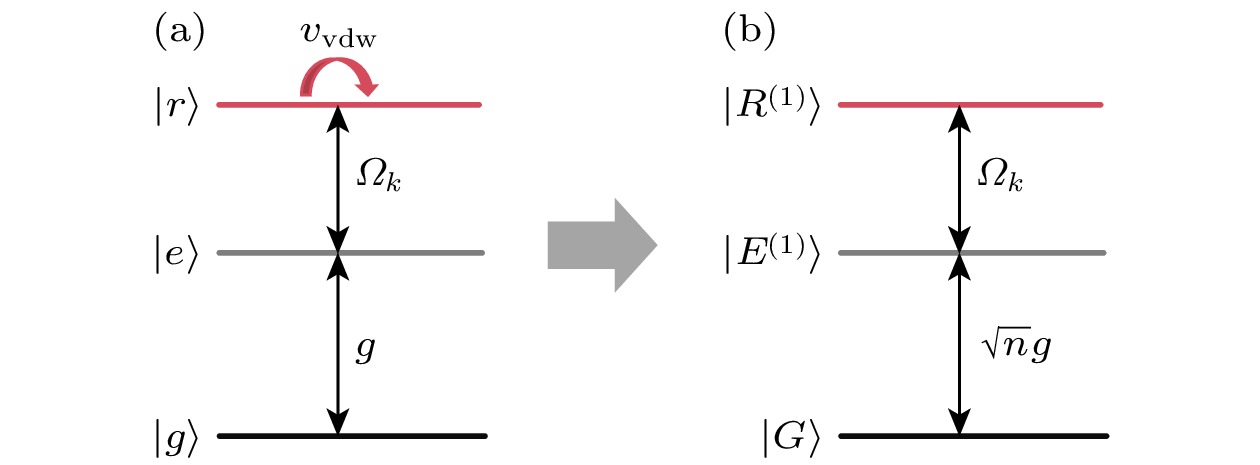
 DownLoad:
DownLoad:
